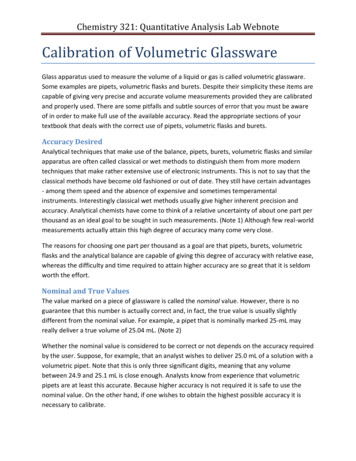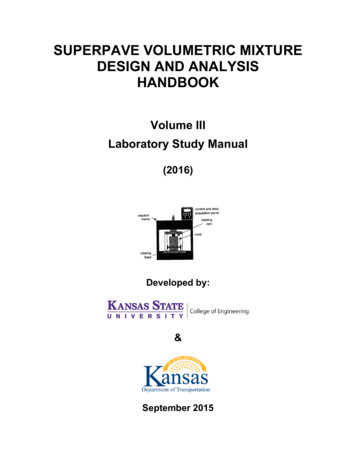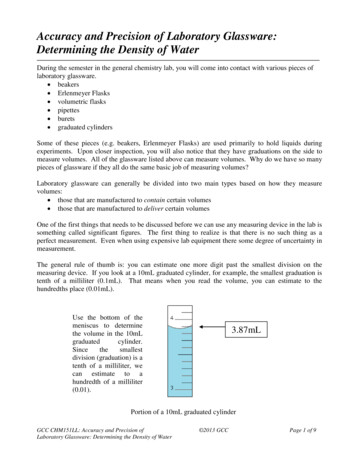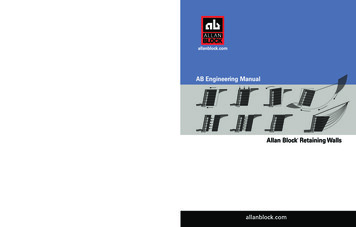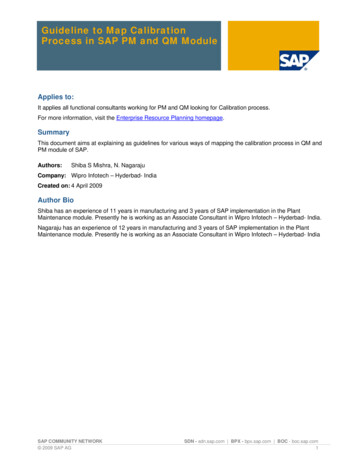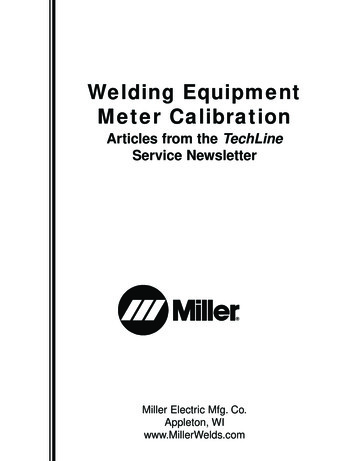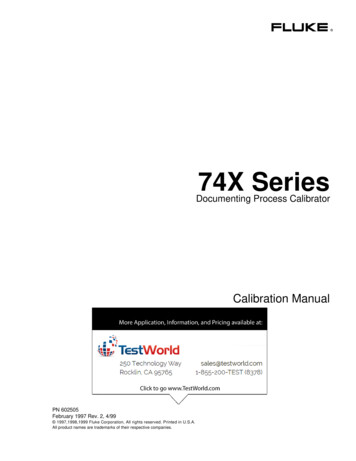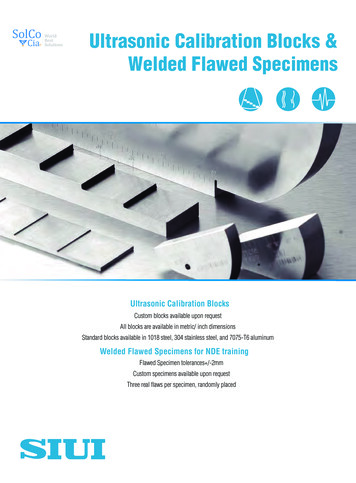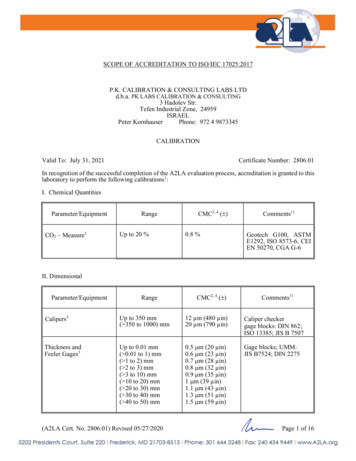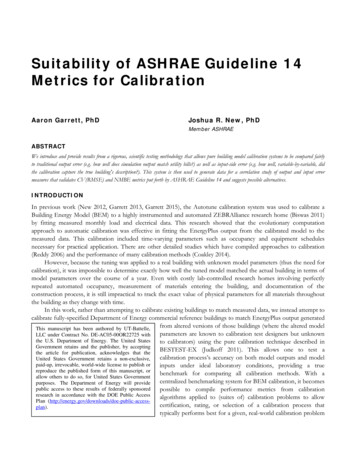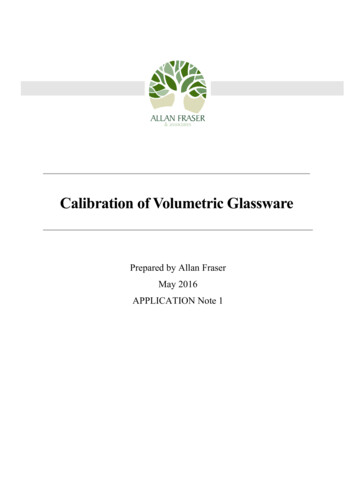
Transcription
Calibration of Volumetric GlasswarePrepared by Allan FraserMay 2016APPLICATION Note 1
TABLE OF CONTENTSTABLE OF CONTENTS . iLIST OF TABLES .ii1. Purpose. 12. Scope . 13. Principle . 14. Abbreviations and Definitions . 15. Material Types . 26. Range . 27. Apparatus and Equipment . 28. Volumetric Flask Calibration. 3REFERENCES . 10APPENDIX . 11i
LIST OF TABLESTable 1. Density of pure water for various temperatures. Corrections for buoyancy forstainless steel weights and the change in the volume of the container have been applied as perSkoog & West (1982), page 727. . 6Table 2. Required tolerances of A- and B class volumetric flasks (source: ASTM E-288-94). 7Table 3. Required tolerances of A-class pipettes (source: ASTM E-288-94). . 7Table 4. Required tolerances of A-class burettes (source: ASTM E-288-94). . 7Table 5. Example calculation for the calibration of a 100ml A-class volumetric flask oftolerance 0.08ml. 98.0336 ml is outside of the 2s tolerance and is therefore excluded in thedata evaluation. . 8ii
1. PurposeThe purpose of this procedure is to provide a method for the calibration of volumetricglassware.2. ScopeThe scope includes volumetric glassware (i.e. designed to contain or deliver an accuratevolume of solution), including pipettes, volumetric flasks and burettes.3. PrincipleThe weight of deionized water contained in the flask or pipette is used to determine the actualvolume contained in the glassware. Water weight is corrected for density differences due totemperature. The method involves weighing a specific volume of water either dispensed orto contain. Corrections for buoyancy are very small and are therefore can be neglected. Thetemperature of the water is measured at time of the calibration after the water has beenallowed to equilibrate to a constant temperature. Multiplication of the obtained mass of waterat some temperature is converted to the volume it would occupy at 20oC. The differencebetween the apparent volume (i.e. that at some temperature) and the true volume is theabsolute error, which should be less than the glassware tolerance. If so, the glassware is forall practical purposes, acceptable for quantitative work. If the absolute error the tolerance, acorrection factor needs to be introduced to correct to the true volume.4. Abbreviations and olume1
5. Material TypesAll volumetric glassware for quantitative work requires calibration.6. RangeAll volumetric glassware used for accurate delivery or to contain specific volumes needs tobe calibrated.7. Apparatus and Equipment7.1Analytical balance accurate to 0.1mg (0.001g)Analytical balance accurate to 0.1g. (For volumes of 100 mL or less, the balance used mustbe capable of measuring in increments of 0.001 g. For volumes greater than 100 mL, thebalance used must be capable of measuring in increments of 0.1 g).7.1.1 Thermometer (0-100oC)High Purity WaterPipette BulbBeaker or weighing boat7.2Cleaning of GlasswareAll glassware to be calibrated must be scrupulously clean before calibration.1. The test for cleanliness of glass apparatus is that on being filled with deionised water,and the water discarded an unbroken film of water remains.2. If the vessel is very dirty and greasy, it can be filled with a warm soap solution for 15minutes, rising several times with deionised water, followed by 50% v/v hydrochloricacid and then rinsed several times with deionised water.2
8. Volumetric Flask Calibration1. Allow a few liters of deionised water in a beaker to equilibrate in terms of temperatureby monitoring the temperature of a thermometer placed in the water. The water shouldbe in the same environment in which the calibration of the volumetric apparatus is tobe done.2. Record the equilibrated water temperature (experimental temperature).3. Record the serial number of the flask. If it does not already exist, add a serial numberto the flask in permanent ink or by attaching a label.4. Wash, dry, weigh, and record the mass of the volumetric flask to be calibrated.5. Fill the volumetric flask to a few millimeters below the mark with deionized water.6. Fill to the mark carefully using a medicine dropper or pipette.7. Wipe dry the outside of the flask and then weigh.8. Record the weight of the flask with the water in it.9. Using Table 1, look up and record the density of the water corresponding to thetemperature recorded in step 2.10. Calculate the expected mass of the flask at the experimental temperature (WTx) as:𝑉𝑓𝑙𝑎𝑠𝑘 𝑊𝑓𝑙𝑎𝑠𝑘 𝑤𝑎𝑡𝑒𝑟 ere:Vflask is the nominal volume of the flask (in mL);Wflask water is the weight of the water recorded in step 8 (in g);Wflask is the weight of the flask recorded in step 4 (in g); and𝜌water is the density of water recorded in step 9 (in gmL-1)3[1]
11. Repeat steps 4 through 10 for at least six replicates.12. Calculate and record the mean, standard deviation (s), and twice the standarddeviation (2s) of the flask volume based on the replicates. These data are then enteredinto the MS Excel sheet ‘Calibration Example 1’.13. Identify any aliquots for which the volume is greater than 2s from the average value.If any aliquots are greater than 2s from the average value remove this datum and treatas an outlier.14. Calculate and record the flask absolute error (i.e. ignore the sign of the computation)based on the following formula:𝐴𝑏𝑠𝑜𝑙𝑢𝑡𝑒 𝐸𝑟𝑟𝑜𝑟 𝑁𝑜𝑚𝑖𝑛𝑎𝑙 𝑓𝑙𝑎𝑠𝑘 𝑣𝑜𝑙𝑢𝑚𝑒 𝑀𝑒𝑎𝑛 𝑎𝑝𝑝𝑎𝑟𝑒𝑛𝑡 𝑣𝑜𝑙𝑢𝑚𝑒 [2]15. Ensure that the absolute error as in [2] is within the limits of a Class A (or B, if that isbeing calibrated) volumetric glassware as listed in Table 2.16. If the absolute error, calculated with the aid of Table 2 falls within the tolerance of theclass of glassware, the glassware may be taken as accurate for all quantitativepurposes. If however, the error is larger than the certified tolerance of the glassware,the simplest procedure is to affix a small label to the flask bearing the true volume andthe date of calibration. It should be noted that the true volume should then be used inthe calculation of concentrations made up in this flask.17. Sign and date the data sheet as shown in Appendix 1.(Skoog & West, 1982)For pipettes the same procedure as described above is to be followed. With the exception ofgraduated cylinders, the tolerances for Class B glassware is typically twice that of a Class Aglassware. (ASTM E694).4
8.1.1 Example CalibrationA 100ml A-class volumetric flask was found to give a mean value (of six replicates) of99.430g of water at 24oC. Refer to Table 5 for the data in this example. The data in Table 1 isused to calculate the volume occupied at this temperature and is found to be:99.430𝑔 𝑥1 99.697𝑚𝑙0.99732𝑔/𝑚𝑙The standard deviation of the six replicates is found to be: 0.82ml. Calculating the 2𝑠 forthe mean based on 2 x 0.82ml:(98.360 101.640)Since one of the values, 98.0336 is outside of the range, it is rejected as an outlier and notincluded in the mean and standard deviation calculations. A new mean excluding this datumis calculated along with a new standard deviation. The 2s is now:(99.947 100.05)The absolute error is calculated and found to be within the tolerance of 0.08 for the 100mlvolumetric flask:𝐴𝑏𝑠𝑜𝑙𝑢𝑡𝑒 𝑒𝑟𝑟𝑜𝑟 100.00 100.041 0.041Since the criterion of the absolute error tolerance has been satisfied (i.e. 0.041 0.08), the100ml volumetric flask is taken as accurate for all quantitative purposes.Should the absolute error tolerance of the flask (e.g. 0.10 0.08), then a correction is madefor the difference in volume.5
Table 1. Density of pure water for various temperatures. Corrections for buoyancy forstainless steel weights and the change in the volume of the container have been applied as perSkoog & West (1982), page 727.Temperature( 22.022.523.0Density(g 7680.99757Temperature( 29.530.06Density(g 567
Table 2. Required tolerances of A- and B class volumetric flasks (source: ASTM olerances ( mL)Class AClass .120.240.200.400.300.600.501.00Table 3. Required tolerances of A-class pipettes (source: ASTM .050.08Table 4. Required tolerances of A-class burettes (source: ASTM E-288-94).Capacity(ml)Tolerance (ml)0.010.020.030.050.25.010.025.050.0100.07
Table 5. Example calculation for the calibration of a 100ml A-class volumetric flask of tolerance 0.08ml. 98.0336 ml is outside of the 2stolerance and is therefore excluded in the data 100100100100W(empty)gT,water Density(g erance (ml) 8W, water ty water)(W,empty) mlV. flask(ml)99.72399.77799.77899.78997.76299.753Mean Volume s Error (ml) .0260.041Calibration factor Corrected Vol. RSD ( % ) ASTMClassification0.9996100.000.026ARange ( 53100.053100.053100.053100.053
8.2Uncertainties in MeasurementWeight of waterDensity of waterError in sighting the level of the waterError in temperature reading8.3How to cite this application note:To cite this applications note, use the following:Fraser A.W. (2016). Volumetric Glassware Calibration. Applications note 1.www.allanfraserandassociates.com and the date that the article was accessed.9
REFERENCESASTM E288-94. Standard speciation for laboratory glass volumetric flasks.Skoog, D., West, D. (1982). Fundamentals of analytical chemistry. 4th Edition. CBS CollegePublishing. Holt Saunders International Editions:725-72810
APPENDIXAppendix 1. Document for recording of relevant information for volumetric flask calibration.The same format can be used for pipettes.Volumetric Flask CalibrationDate:Calibration Due Date:Flask IdentificationManufacturer:Nominal Volume:Serial Number:Step 3.mLTolerance: mLCalibration of FlaskStep 4 - Mass of Empty Flask:RungStep 7Step 2Step 9Step(g)( C)(g mL-1)12Average Volume:(mL)Absolute st:11mLmL
The purpose of this procedure is to provide a method for the calibration of volumetric glassware. 2. Scope The scope includes volumetric glassware (i.e. designed to contain or deliver an accurate volume of solution), including pipettes, volumetric flasks and burettes. 3. PrincipleFile Size: 733KBPage Count: 14
